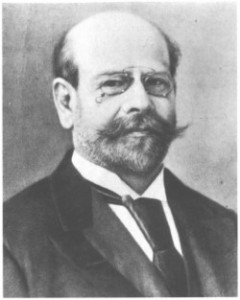Emil Moritz Rathenau was born in Berlin on December 11, 1838. His father was a wealthy Jewish businessman named Moritz Rathenau. He is a German industrialist and a leading figure in early European electrical industry. As a child, Rathenau attended the Berlin boys’ school of Marggraf and high school. He left the school after Obersekunda (seventh year of German secondary school).
From 1855-1859, Rathenau received practical training in engineering under his uncle in Lower Silesia. He studied Mechanical Engineering at the Polytechnikum in Hannover and also at the ETH Zurich (Swiss Federal Institute of Technology in Zurich) from 1859-1862. Interestingly, Albert Einstein later attended the same school and taught as a professor from 1909-1912. Rathenau spent a short period of time at the August Borsig locomotive factory in Berlin and went to England for two years, where he engaged in engineering works and deepened his technical knowledge. In 1865, Rathenau acquired a small machine factory in Berlin with his high school friend, Julius Valentin. Rathenau successfully ran the company and profitably produced unit steam engines. When Rathenau could not prevent the eventual conversion of the company into a joint stock corporation, he resisted the plan and the operation was later liquidated because of founder crisis. He left the company with business reputation temporarily damaged.
In the following ten years, Rathenau was pulled back from professional life and traveled extensively across the globe. He attended the 1873, 1876, and 1878 world exhibitions in Vienna, Philadelphia, and Paris, respectively. In 1881, Rathenau attended the International Electricity Exhibition in Paris and was fascinated by Thomas Edison’s improved incandescent bulb. Rathenau thought of machines as “the tools for the future” and in 1883, he founded the Deutsche Edison-Gesellschaft fur Angewandte Elektriciatät (German Edison Society for Applied Electricity) based on Thomas Edison’s patents, for which he acquired the right to use across Europe. The company was later renamed Allegmeine-Elektrizitäts-Gesellschaft (AEG, , General Electricity Incorporated) in 1887, when Rathenau detached the company from the American Edison Company. AEG eventually developed into a worldwide enterprise, operating in 18 countries, including: Austria, Switzerland, Italy, France, Belgium, Great Britain, Spain, Romania, Bulgaria, Russia, Denmark, Norway, Sweden, South Africa, Mexico, Brazil, Chile, and Argentina. Rathenau possessed a well-acclaimed “Manager Entrepreneur” leadership style, unlike the Siemens’ family-run business style of the time. At the turn of the 20th century, he successfully led the company to thrive from the electrical industry crisis through aggressive sales strategies and active patent acquisitions.
Additionally, in February of 1884, Rathanau and the Magistrate of Berlin signed an agreement that allowed Rathanau’s company the use of public streets for electricity lines. In return, the agreement also stated that the city received ten percent of the income. The agreement has been called Germany’s first private-public partnership by energy experts. Almost two decades later, in 1903, Rathenau partnered with his competitor, Werner von Siemens, noted German engineer, and established the Telefunken Gesellschaft für drahtlose Telegraphie mbH. Rathenau was also the first to produce aluminum in Germany for industrial use.
Rathenau not only managed a successful business career but also enjoyed a satisfying family life. In 1866, Rathenau married Mathilde Nachmann. They had two sons, Walter and Erich, and a daughter, Edith. Walther Rathenau, the elder son, would become a famous industrialist, politician, and economist. Walther became the president of AEG after Emil’s death on June 20, 1915.
Rathenau and his wife, Mathilde (1881)

